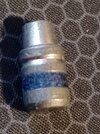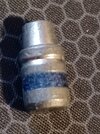tws3b2
Member
New to reloading. My only goal is to reload some 38spl and 9mm. Mild loads. Not interested in +P, magnum or hot rounds. Or, any other calibers. Just to have something to mess with during wet/cold/rainy winter days, to have a backup during ammo shortages and portable.
I have reloaded some 38spl, 158gr, Hornady XTP using w231 powder. I have 38 and 9mm Lee Precision loading kits. I want to keep it easily portable so I need nothing else. I'm going to stick with w231 or hp38 powder for both calibers.
At the lgs I picked up a box/500 round 38spl, 158gr .358, swc bullets made by Alpha Bravo mfg llc in Pa. I looked up the company to see if they provided any loading data. Apparently they are no longer in business. No website and their email does not work. Seems they were in business for 13 years, but no longer. Unlucky 13 I guess.
I use 38spl and 9mm loading manuals + Hodgdon for data. I like using Hodgdon, simple, fast and no clutter. Just works for what I want for me. Just put in caliber, bullet, powder and there you go. Simple.
Now where I get confused.
I compared Hornady, Speer and Hodgdon 38spl, 158gr, .358, SWC, w231 powder data.
Hornady minimum 3.2 gr - max 4.4 gr powder - SWC bullet.
Speer min. 3.8 - max 4.3 - Lswc bullet.
Hodgdon min.3.1 - max 3.7 - Lswc bullet.
Where I'm confused. Minimum 3.1 - 3.8. Max 3.7 - 4.4. ?
Swc - Lswc. In know the L = lead. Is there a difference?
Why the wide range in powder weight? All for 38spl, 158gr, .358 bullet. What makes the difference?
Which load would I use?
I have reloaded some 38spl, 158gr, Hornady XTP using w231 powder. I have 38 and 9mm Lee Precision loading kits. I want to keep it easily portable so I need nothing else. I'm going to stick with w231 or hp38 powder for both calibers.
At the lgs I picked up a box/500 round 38spl, 158gr .358, swc bullets made by Alpha Bravo mfg llc in Pa. I looked up the company to see if they provided any loading data. Apparently they are no longer in business. No website and their email does not work. Seems they were in business for 13 years, but no longer. Unlucky 13 I guess.
I use 38spl and 9mm loading manuals + Hodgdon for data. I like using Hodgdon, simple, fast and no clutter. Just works for what I want for me. Just put in caliber, bullet, powder and there you go. Simple.
Now where I get confused.
I compared Hornady, Speer and Hodgdon 38spl, 158gr, .358, SWC, w231 powder data.
Hornady minimum 3.2 gr - max 4.4 gr powder - SWC bullet.
Speer min. 3.8 - max 4.3 - Lswc bullet.
Hodgdon min.3.1 - max 3.7 - Lswc bullet.
Where I'm confused. Minimum 3.1 - 3.8. Max 3.7 - 4.4. ?
Swc - Lswc. In know the L = lead. Is there a difference?
Why the wide range in powder weight? All for 38spl, 158gr, .358 bullet. What makes the difference?
Which load would I use?




